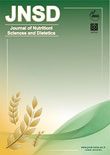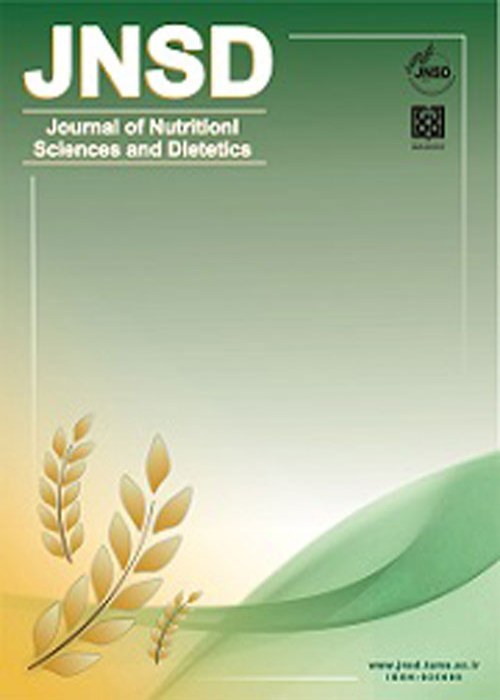فهرست مطالب

Journal of Nutritional Sciences and Dietetics
Volume:1 Issue: 4, Autumn 2015
- تاریخ انتشار: 1394/12/07
- تعداد عناوین: 8
-
-
Pages 171-172Accumulating evidence suggests that higher intakes of omega-3 (n-3) long chain polyunsaturated fatty acids (LC-PUFA), especially eicosapentaenoic acid (EPA) and docosahexaenoic acid (DHA), have various beneficial health in man [1]. Based on research findings in many countries, there has been considerable enthusiasm for using n-3-fatty acids (n-3-FAc) to lower the risk of mental health, inflammatory diseases, immunological disorders and, although somewhat controversial, cardiovascular disease, cancer and mortality [2-3]. It is too be noted that Iran, too, has been involved in this area of clinical research in recent decades, showing the benefits of n-3 FAs in a wide range of cardiovascular risk factors, lipid profile, blood pressure, cardiac function, inflammatory markers, triglycerides, HDL-cholesterol, adipokines, and insulin[4-5], as well as in depression[6] and sport performance[7]. Also, in this issue of JNSD two papers address the beneficial effects of n-3-FA supplementation on heat shock proteins 27 (HSP-27), which can play an important role in the pathogenesis of atherosclerosis (S. Samavat et al.), and on lifestyle modification on depression and anxiety in overweight women (S. Haghravan et al.).Various doses of EPA/DHA have been recommended by international organizations (IOM or AHA), but most n-3-FA experts recommend 500-1000 mg of n-3 EPA/DHA per day for adults to maintain overall good health[8]. Moreover, for patients with documented CHD, the AHA recommends about 1 gram of EPA and DHA (combined) per day. This may be obtained from oily fish or n-3-FA supplements [9]. Widespread advertisement in the media and extensive public health attention to the benefits of n-3-FAs on different aspects of health have led to increased consumption of fish and n-3-FA supplements in populations in many countries. However, the dietary recommendations are not being fully met by most people. Now the vital question is from which sources should sufficient intakes of n-3-FAs be provided?Undoubtedly, dietary approaches are safer and less costly to reduce cardiovascular disease risk and n-3-FA deficiency which is associated with substantial direct and indirect costs. With better reservoir knowledge and advance in scientific technologies, production of n-3s from some unconventional and economically viable sources should be considered. Recently a study has described potential alternative sources of n-3-LC-PUFA including a) algae, which can be used to produce oils rich in both DHA and EPA, although using expensive methodology; b) krill oil, which does not seem to be a major alternative source and is more expensive than fish oil; c) stearidonic acid (SDA)-enriched soybean oil, which is a less expensive than fish; and d) single-cell photosynthetic organisms, which have the potential to convert CO and salt water directly into n-3 fatty acids[10].Despite the beneficial effects of n-3-FAs in reducing risk of some chronic diseases, their intake is very low in many populations, including Iran [5]. Then, we may need to pay attention to other n-3 fatty acid sources than oily fish and to make a strong capacity for the above-mentioned low-cost innovations in Iran.
-
Pages 173-180BackgroundThe aim of this study was to survey Knowledge, attitude and practice (KAP) of fast foods, soft drinks, salt and oil in urban and rural regions in Iran.MethodsIn this cross-sectional study, Iranian households in both rural and urban areas of 31 provinces of Iran (2011-2012) including 14,136 persons who were responsible for cooking in family were studied. The sampling method was the single-stage cluster sampling with equal size clusters at households in each province. The data was gathered by using a structured questionnaire covering demographic variables, knowledge, attitude and practice about fast foods, soft drinks, salt, and oil by interview with the qualified person.ResultsHouseholds in urban areas had higher correct knowledge level and favorable attitude toward fast foods, soft drinks, salt and oil than households in rural areas. The consumption of sausage, junk food, soft drink and synthetic juice was higher in rural (pConclusionThe results of our study indicated that the nutrition KAP of Iranian population was acceptable. It showed that earlier nutritional educations were effective and helpful.Keywords: Knowledge, Attitude, Practice, Fast foods, Soft drinks, Salt, Oil
-
Pages 181-187BackgroundAnxiety, stress and depression are still one of the common chronic diseases among Iranian population especially among women in the age of 15-29 years. Associations between depressed mood and lifestyle are well known. The aim of this study was to investigate the effect of omega-3 poly unsaturated fatty acids (PUFA)s supplementation with lifestyle modification on depression and anxiety in overweight women.MethodsThirty eight women aged between 20-45 years; body mass index (BMI) equal 25-30; having sedentary lifestyle without any known metabolic, cardiovascular or pulmonary diseases or taking any medication which affect heart rate, blood pressure or exercise capacity were included. Patients randomly divided into two experimental groups. Group 1 received omega-3 capsules plus aerobic exercise and nutrition education classes. Group 2 received placebo capsules plus aerobic exercise and nutrition education classes. All of the subjects in group 1were asked to take one capsule/day, for 8 weeks. The depression level was measured using the Hospital Anxiety and Depression Scale.ResultsThere were no significant differences between anxiety and educational level, depression and educational level in overweight women at baseline, 4 and 8 weeks of the study. In addition, no significant correlation was found between changes observed on anxiety and depression extent and different occupations among volunteer women at baseline, 4 and 8 weeks of the study. Omega-3 capsules significantly decreased anxiety and depression compared to control group (P=0.032).ConclusionIt seems omega-3 supplementation could have positive effects on anxiety and depression treatment in overweight women.Keywords: Omega-3, Fatty acids, Depression, Anxiety, Overweight Women
-
Pages 188-193BackgroundHeat shock proteins 27 (HSP-27) can play an important role in the pathogenesis of atherosclerosis. Omega-3 fatty acids include anti-inflammatory eicosanoids and contribute to the primary and secondary prevention of cardiovascular disease (CVD). The purpose of the current study is to assess the effect of omega-3 on serum HSP-27 in patient with atherosclerosis.MethodsIn a double‐blind placebo-controlled trial study, 42 patients were selected from Tehran Heart Hospital. Both intervention (n=21) and placebo (n=21) groups were men with cardiovascular disease (based on Angiography). The intervention group received omega-3 supplement and placebo group took edible paraffin. Dietary intakes, physical activity level, anthropometric parameters and body composition, were measured. Serum HSP-27 concentration was determined using ELISA.ResultsAfter two months, change differences in HSP-27 between two groups was statistically significant (p=0.001). This difference remained significant even after adjusting for serum LDL concentration (p=0.002).ConclusionsOur results showed that taking omega-3 fatty acids can ameliorate serum HSP-27 as inflammatory parameters. Our results suggest more investigation to assess the pathway omega-3 leads to lower incidence of CVD.Keywords: HSP, 27, cardiovascular disease, Omega, 3 fatty acid
-
Pages 194-198ObjectiveNowadays, zinc deficiency is common among both low- and high-economic level people. Finding the predisposing factors -other that economic situation- seems considerable. Current study investigated the serum concentration of zinc and its correlation with different parameters among disadvantaged female population under cover of a relief foundation in Iran.MethodsIn an analytical cross-sectional study, 1026 females aged 18-30, from all around of Iran were enrolled. Demographic and anthropometric data were registered and venous blood samples were collected. Serum zinc levels were compared in different groups of participants based on age, body mass index, education level and geographic region of their residence. Correlation between serum zinc and iron was investigated as well.ResultsMean serum zinc was 78.3±13.7 μg/dL. Significant difference was detected between mean serum zinc among different BMI groups (ANOVA, p=0.03), while it was not significant in different education levels and age intervals (ANOVA, p=0.61 and 0.95 respectively). Participants from two western provinces of Iran (Khoozestan and Lorestan) had significantly higher zinc level. There was a positive relationship between serum iron and zinc (Pearson correlation coefficient, r=0.1, p=0.001).ConclusionsFindings reveal the important role of socioeconomic and geographic situations and their effect on nutritional status in populations. Other researches focusing on food accessibility, eating behaviors, knowledge level and other reasons that expose poor populations to insufficient nutritional intake are recommended.Keywords: Zinc, Socioeconomic, Female, Disadvantaged, Iran
-
Pages 199-205BackgroundThis study compares the effects of canola and rice bran oil consumption on serum malondialdehyde and blood pressure in postmenopausal type 2 diabetic women.Method75 participants were allocated to 3 groups including a control group (taking 30g/day sunflower oil), canola oil (CO) group (taking 30g/day) and rice bran oil (RBO) group (taking 30g/day). Measurements were performed at baseline and after 8 weeks.ResultsResults showed that reduction of MDA level were significantly higher in RBO (pConclusionConsuming either CO or RBO could decrease the levels of MDA and oxidative stress in diabetic patients, however RBO is more effective than CO. Neither of the oils has any significant impact on blood pressure of diabetic women.Keywords: Canola oil, rice bran oil, oxidative stress, blood pressure, diabetic women
-
Pages 206-212BackgroundPopulation aging is accompanied by higher prevalence of MetS, which varies depending on the population studied. The objective this study is to determine prevalence of MetS in Iranian elderly.Methods245 of elderly residents in private nursing house in Tehran (90 men and 155 women) were studied. MS was defined according to National Cholesterol Education Program: Adult Treatment Panel III (NCEP ATP III) criteria. They were evaluated by clinical examination, fasting glucose, fasting insulin, lipid profile and anthropometric measurements - weight, height, waist circumference and systolic and diastolic blood pressure. The prevalence of MetS was estimated by NCEP ATP III.Result57.5% showed normal status while 39.2% have MetS. Analysis of logistic regression in two groups, after adjustment for gender, education, marital and vocation status and smoking habit, showed that the risk of MetS in elderly women 2-fold were higher than men (OR: 2.077, CI: 1.198-3.601 and p = 0.009).ConclusionOur study indicates that MetS is highly prevalent in the elderly people particularly among women. These results highlight an immediate action of preventive measures programs for modification of cardio metabolic risk factors in elderly population.Keywords: Metabolic syndrome in elderly, National Cholesterol Education Program: Adult Treatment Panel III (NCEP ATPIII), Insulin resistance
-
Pages 213-230BackgroundObservational studies suggest that dietary pattern intake plays an important role in the development of fracture and low bone mineral density (BMD). However, the association remains unclear. This systematic review was performed to evaluate the relationship between dietary patterns and fracture and BMD by pooling available data from existing studies.MethodsMEDLINE and EMBASE databases were searched up to January 2015 for eligible observational studies regarding the relationships between common dietary patterns and risk of fracture/ low BMD. Random-effects models were applied to pool the summary estimates for the highest versus the lowest category of dietary pattern. Sensitivity analyses were conducted and publication bias was assessed using Begg or Egger's tests.ResultsA total of thirteen cross-sectional studies were included in the meta-analysis. There was evidence of inverse associations between the Healthy/Prudent dietary pattern and the risk of low BMD (OR: 0.75; 95% CI: 0.21 to 1.30; p =0.007) and a positive association between Unhealthy/Western dietary pattern and low BMD risk (OR: 1.21; 95% CI: 0.58 to 1.90; pConclusionThere appears to be a beneficial effect of healthy dietary pattern on fracture and low BMD risk and adding a new direction toward prevention of fracture and low BMD level on population level.Keywords: Bone mineral density, fracture, dietary pattern, meta, analysis, systematic review


